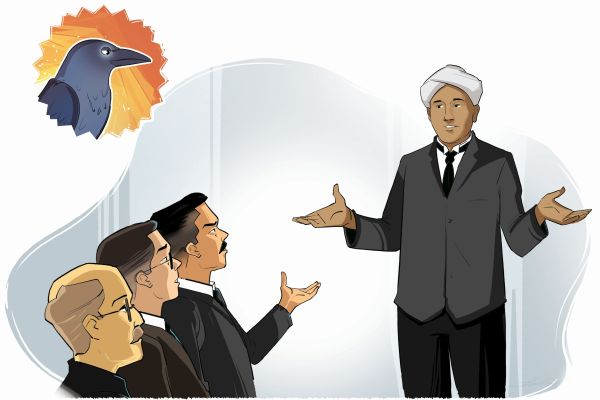The Raman Effect
- POSTED ON: 21 Feb, 2024
- TOTAL VIEWS: 781 Views
- POSTED BY: R. Krithika | Text: Jagadeesh Kanna
- ARTICLE POINTS: 150 Points
(Previous episode: The world in an egg)
After his meeting with Sage Lomasa, Kakabhushundi entered the wormhole to go back to the time he saw Rama. He was thinking about the sage’s words about the purpose of his life being knowledge transfer. At the coordinate point of the time-travelling wormhole, Kakabhushundi got pulled into the future because he wanted to meet a Rama who was famous for his scientific knowledge.
Imagine his surprise when he landed in a physics conference in 1922 where a scientist called Chandrasekhara Venkata Raman was talking about his research on the scattering of light.

Illustration: Sahil Upalekar
C.V. Raman: In 1921, while on a ship to England, I noticed something amazing. The colour of the Mediterranean Sea was a dark blue. I began to wonder why that was so.
Scientist: Didn’t you know that the scientist Raleigh said that the ocean reflects the colour of the sky?
C.V. Raman: Yes, I am also a fan of Raleigh’s work on light optics but I think there is something more here. If the waters were reflecting the colour of the sky, why was the sea dark blue and not sky blue?
Though none of the scientists had an answer to this question, they did not like the fact that Raman had questioned Raleigh’s work. Some even start questioning Raman’s knowledge. Kakabhushundi, sitting outside the room, listened to the heated debate.
C.V. Raman: The reason for the colour of the Mediterranean Sea is not just reflection of light but also scattering of light. I wrote to the science journals about this phenomenon as soon as the ship docked at the next port.
Having said this, Raman performed a simple experiment, using a light source with a violet filter to pass through glycerin. The spectrometer showed a blue light along with violet light. The audience was stunned.
Curious, Kakabhushundi decided to travel further into the same year, where Raman is presenting another research paper on “Molecular scattering of light in water and the colour of the sea”. After he finishes, Raman received an ovation.
Kakabhushundi is even more intrigued to see what happens next in C.V. Raman’s life and travels to 1930. That year, on February 28, C.V. Raman is awarded the Nobel Prize for Physics, the first Indian to receive the award in a scientific discipline and the second to receive a Nobel Prize after Rabindranath Tagore in 1913. After watching the scientist receive the award, Kakabhushundi returns to Sage Lomasa.
Kakbhushundi: Even though C.V. Raman is an Indian, he received the award under a British flag.
Sage Lomasa: Don’t worry about that. It is all part of the process of evolution. But tell me, what was the discovery of the Rama you met?
Kakabhushundi: I didn’t exactly understand it but it seems like he has discovered the different names of the Surya’s seven horses and how they behave.
Sage Lomasa: His discovery is known as the Raman Effect and February 28, the day he received the Nobel Prize, is celebrated as National Science Day in India. Since you say you didn’t understand it, let me show you what he meant with this experiment.
Kakabhushundi: This is all too much to take in. I have to give my brain some rest before I learn any more science. But I am also prepared now for knowledge transfer across multiverses.
Kakabhushundi flies off, after bidding Sage Lomasa goodbye.
The author is the founder and CEO of Vaayusastra Aerospace, an IIT-Madras incubated ed-tech startup that offers Air Science workshops for children between five and 14 years.